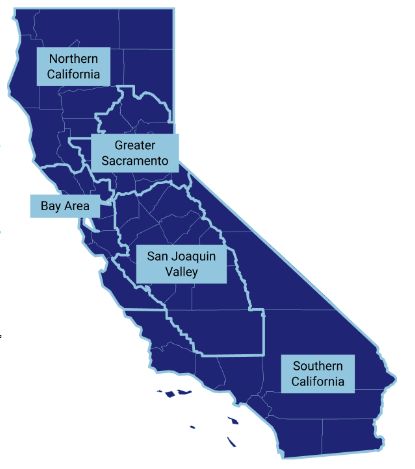- within Compliance, Consumer Protection, Government and Public Sector topic(s)
- with readers working within the Banking & Credit, Business & Consumer Services and Construction & Engineering industries
Seyfarth Synopsis: Effective December 5, 2020, California businesses may be subject to a new Regional Stay At Home Order. The Order divides the State into five regions and will place new restrictions on businesses in regions where the ICU availability drops below 15%. For impacted regions, the Order will close bars, salons, personal care services, and many entertainment businesses. Among other things, the Order will also place tighter capacity restrictions on retailers, limit the number of guests hotels can accept, and restrict restaurants to takeout and delivery operations.
On December 3, 2020, Governor Gavin Newsom announced an additional level of potential restrictions on businesses due to the spike in COVID-19 cases across the Golden State. The new Order, dubbed a " Regional Stay At Home Order," will take effect on December 5, 2020. These new business restrictions will go into effect within 24 hours in regions where the ICU availability dips below 15%. The restrictions will remain in effect for at least three weeks thereafter.
The State's five regions as depicted in the below map are:
- Northern California: Del Norte, Glenn, Humboldt, Lake, Lassen, Mendocino, Modoc, Shasta, Siskiyou, Tehama, Trinity Counties

- Bay Area: Alameda, Contra Costa, Marin, Monterey, Napa, San Francisco, San Mateo, Santa Clara, Santa Cruz, Solano, Sonoma Counties
- Greater Sacramento: Alpine, Amador, Butte, Colusa, El Dorado, Nevada, Placer, Plumas, Sacramento, Sierra, Sutter, Yolo, Yuba Counties
- San Joaquin Valley: Calaveras, Fresno, Kern, Kings, Madera, Mariposa, Merced, San Benito, San Joaquin, Stanislaus, Tulare, Tuolumne Counties
- Southern California: Imperial, Inyo, Los Angeles, Mono, Orange, Riverside, San Bernardino, San Diego, San Luis Obispo, Santa Barbara, Ventura Counties
When read with the concurrently released guidance, the Order allows the following businesses to remain open once a region's ICU capacity triggers the Order's restrictions:
- Critical infrastructure sectors may remain open provided they continue to modify operations pursuant to the California's Industry Specific Guidance.
- Retailers (both essential and non-essential) may remain open provided they limit indoor capacity to 20%. Retailers must also (1) follow the State's guidance for retailers; (2) strictly monitor access into and occupancy of their facilities; (3) prohibit in-store consumption of food, beverages, and alcohol, and (4) institute special hours for seniors and those with chronic conditions or compromised immune systems.
- Hotels and lodging are allowed to remain open for critical infrastructure support only. Though not expressly stated, the Order permits hotels and lodging entities to continue to accept out-of-state reservations for essential travel. However, any out of state reservations for non-essential travel are explicitly prohibited under the Order, unless the reservation is for at least the minimum time period required for quarantine, and the persons identified in the reservation will quarantine in the hotel or lodging entity until after that time period has expired.
- Restaurants may remain open for take-out, pick-up, or delivery operations only.
- Non-urgent medical and dental care operations may continue provided the business requires 100% masking, physical distancing, and follows other required safety measures.
- Child care and pre-K operations may continue provided the business requires 100% masking, physical distancing, and follows other required safety measures.
- Schools may remain open provided they have received a waiver to operate in-person learning
- Outdoor recreation facilities may remain open provided they do not sell food or drink for on-site consumption. Overnight stays at campgrounds are prohibited.
- Places of worship may remain open for outdoor services only.
- Offices workspaces must operate remotely except for critical infrastructure sectors where remote working is not possible.
Other businesses not listed in the Order must close in impacted regions. The guidance issued with the Order specifically lists the following businesses:
- Indoor and outdoor playgrounds
- Indoor recreational facilities
- Hair salons and barbershops
- Personal care services
- Museums, zoos, and aquariums
- Movie theaters
- Wineries
- Bars, breweries, and distilleries
- Family entertainment centers
- Cardrooms and satellite wagering
- Limited services
- Live audience sports
- Amusement parks
For updates on ICU capacities, visit the State's COVID-19 website, here. As of December 3, none of the regions had fallen below the 15% ICU capacity threshold. However, during his press conference, the Governor warned that the State anticipates all regions will fall below the threshold in the coming days and weeks.
The new Order does not change California's existing tiered restrictions established in the Blueprint for a Safer Economy. When triggered, the new Order supersedes any conflicting terms. Fifty-two of California's fifty-eight counties are currently in the Blueprint's most restrictive Tier 1 (Purple / Widespread). Businesses must continue to abide by the restrictions in the Blueprint as well as any city or county-specific restrictions, unless the new Order imposes stricter restrictions. Likewise, once the Order's restrictions are lifted for a particular region, each of the counties within that region must again adhere to the restrictions imposed by their respective assigned tier.
Workplace Solutions
Be sure to contact Seyfarth for further updates to California's ever-changing landscape of COVID-19 related restrictions. We continue to closely monitor California COVID-19 developments at our COVID-19 Resource Center. You can also contact your favorite Seyfarth attorney directly if you have any questions.
Originally Published by Seyfarth Shaw, December 2020
The content of this article is intended to provide a general guide to the subject matter. Specialist advice should be sought about your specific circumstances.





